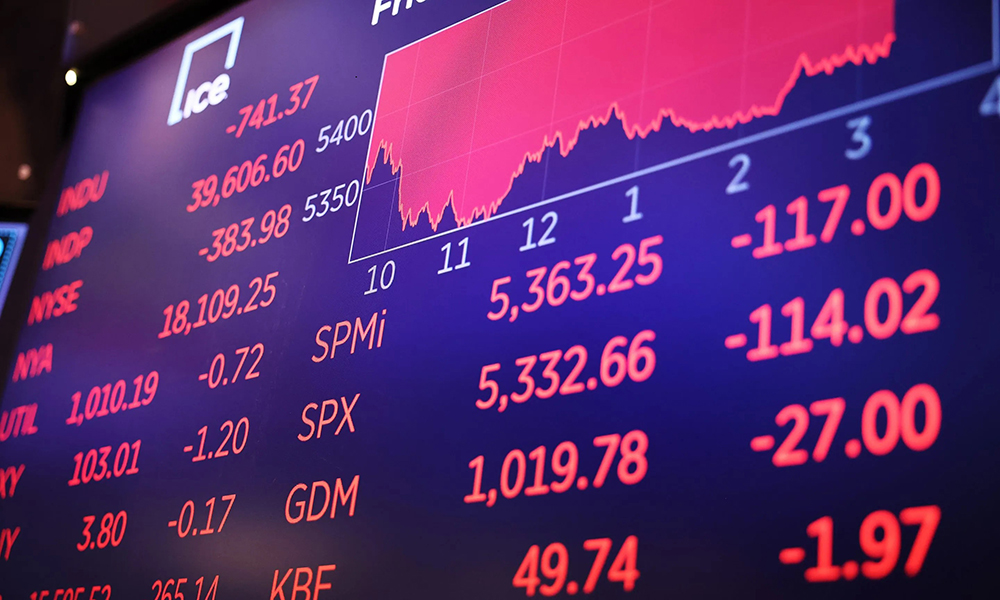
继全球股市遭遇抛售之后,周一美国股市也大幅下挫,令投资者对经济衰退的担忧甚嚣尘上。但金融专家指出,如今还不是担心的时候,并指出回调属于正常现象。鉴于股票近期价格达到前所未有的高位,一些专家认为,此刻以折扣价买入并非糟糕的决策。马萨诸塞州注册理财规划师(CFP)凯瑟琳·瓦莱加(Catherine Valega)表示,虽然这看似有悖常理,但对于那些处于"积累模式"(这一术语指的是离退休还有几年时间)的人来说,在价格下跌时买入股票不失为一种选择。
瓦莱加称:“没错,要继续买入。倘若你有闲置资金,在激进、多元化的股票投资组合追加投入会是良策。”
因此,如果你愿意,可以适度增持。也就是说,当下正是真正实践你可能熟知的那些投资准则的好时机。买入并持有。不要试图把握市场时机,要保持美元成本平均法。
德克萨斯州的注册理财规划师安德鲁·赫佐格(Andrew Herzog)表示,最后一条准则意味着,无论市场走势如何,都不应改变策略。如果你一直投入相同的金额——例如,通过每两周从工资中扣除一定款项投入401(k)计划——那么就无需变更。随着时间的推移,美元成本平均法有助于投资者在价格较低时买入更多投资产品,在价格较高时买入更少的投资产品。
赫佐格说:"如此一来,你就能排除情绪干扰。对于长期投资的普通投资者而言,这是一个很好的策略。"
对于那些在市场波动如此剧烈的情况下对投资感到不安的人来说,赫佐格提及了诸如第二次世界大战、金融危机、疫情等重大灾难性事件后的市场复苏情况。就最近的这次暴跌(这是自1987年以来的最大跌幅)而言,值得留意的是,今年股票仍呈上涨态势。
"从历史上看,标准普尔500指数在经历了20次最大的市场波动(正如我们今天看到的这样)之后表现如何?[其]在接下来的一年里的平均上涨了17.5%,"他表示,引用了财富管理公司Creative Planning的首席市场策略师查理·比列洛(Charlie Bilello)整理的图表。"要用短期痛苦,换取长期收益。"
倘若你此刻决定用部分额外的现金买入——切勿动用应急基金,而是动用你可能拥有的任何盈余资金。如果尚未设立应急基金,应首先关注此事——切记股票价格可能会进一步下跌。因此,这并非短期操作。相反,只有当你计划长期持有时,才应逢低买入。
最重要的是,我们无法确切预知接下来的市场走向。这可能是股市下滑的尽头,也可能是更深层次调整的开端。对于多数投资者而言,在市场高点与低点均维持一贯的投资策略方为上策。佛罗里达州的注册理财规划师马特·钱西(Matt Chancey)表示,临近退休的老年投资者可以考虑重新平衡投资组合。
钱西称:“市场向来具有周期性,而且未来亦将如此。在缺乏明确的美元成本平均法或持续再平衡流程的情况下,试图低买高卖纯属徒劳之举。不要拿你的储蓄冒险。”
而且绝对不要像这位Reddit用户提议的那样做:现在卖出,待确定股票价格更低时再买入。低点根本无从预知。(财富中文网)
译者:中慧言-王芳
继全球股市遭遇抛售之后,周一美国股市也大幅下挫,令投资者对经济衰退的担忧甚嚣尘上。但金融专家指出,如今还不是担心的时候,并指出回调属于正常现象。鉴于股票近期价格达到前所未有的高位,一些专家认为,此刻以折扣价买入并非糟糕的决策。马萨诸塞州注册理财规划师(CFP)凯瑟琳·瓦莱加(Catherine Valega)表示,虽然这看似有悖常理,但对于那些处于"积累模式"(这一术语指的是离退休还有几年时间)的人来说,在价格下跌时买入股票不失为一种选择。
瓦莱加称:“没错,要继续买入。倘若你有闲置资金,在激进、多元化的股票投资组合追加投入会是良策。”
因此,如果你愿意,可以适度增持。也就是说,当下正是真正实践你可能熟知的那些投资准则的好时机。买入并持有。不要试图把握市场时机,要保持美元成本平均法。
德克萨斯州的注册理财规划师安德鲁·赫佐格(Andrew Herzog)表示,最后一条准则意味着,无论市场走势如何,都不应改变策略。如果你一直投入相同的金额——例如,通过每两周从工资中扣除一定款项投入401(k)计划——那么就无需变更。随着时间的推移,美元成本平均法有助于投资者在价格较低时买入更多投资产品,在价格较高时买入更少的投资产品。
赫佐格说:"如此一来,你就能排除情绪干扰。对于长期投资的普通投资者而言,这是一个很好的策略。"
对于那些在市场波动如此剧烈的情况下对投资感到不安的人来说,赫佐格提及了诸如第二次世界大战、金融危机、疫情等重大灾难性事件后的市场复苏情况。就最近的这次暴跌(这是自1987年以来的最大跌幅)而言,值得留意的是,今年股票仍呈上涨态势。
"从历史上看,标准普尔500指数在经历了20次最大的市场波动(正如我们今天看到的这样)之后表现如何?[其]在接下来的一年里的平均上涨了17.5%,"他表示,引用了财富管理公司Creative Planning的首席市场策略师查理·比列洛(Charlie Bilello)整理的图表。"要用短期痛苦,换取长期收益。"
倘若你此刻决定用部分额外的现金买入——切勿动用应急基金,而是动用你可能拥有的任何盈余资金。如果尚未设立应急基金,应首先关注此事——切记股票价格可能会进一步下跌。因此,这并非短期操作。相反,只有当你计划长期持有时,才应逢低买入。
最重要的是,我们无法确切预知接下来的市场走向。这可能是股市下滑的尽头,也可能是更深层次调整的开端。对于多数投资者而言,在市场高点与低点均维持一贯的投资策略方为上策。佛罗里达州的注册理财规划师马特·钱西(Matt Chancey)表示,临近退休的老年投资者可以考虑重新平衡投资组合。
钱西称:“市场向来具有周期性,而且未来亦将如此。在缺乏明确的美元成本平均法或持续再平衡流程的情况下,试图低买高卖纯属徒劳之举。不要拿你的储蓄冒险。”
而且绝对不要像这位Reddit用户提议的那样做:现在卖出,待确定股票价格更低时再买入。低点根本无从预知。(财富中文网)
译者:中慧言-王芳
U.S. stocks tanked Monday following a global sell-off, sending investors into a tizzy with recession fears. But it’s not time to worry yet, say financial experts who point out that pullbacks are normal. And given how stocks were recently more expensive than ever, it’s not a terrible idea to buy at what some experts call a discount. Though it might seem counterintuitive, buying when prices drop is an option for those in “accumulation mode”—a term that describes those years from retirement—says Catherine Valega, a Massachusetts-based certified financial planner (CFP).
“Yes, yes, yes. Keep buying,” says Valega. “If you have cash on the sidelines it would be great to add more to an aggressive, diversified, stock portfolio.”
So you can buy a bit more if you like. That said, now is a good time to actually practice all of those investing maxims you’re likely familiar with. Buy and hold. Don’t try to time the market. Keep dollar-cost averaging.
That last bit means not changing up your strategy at all, no matter what the markets are doing. If you are consistently investing the same amount—say, through a biweekly paycheck deduction to your 401(k)—then there’s no need to change it up, says Andrew Herzog, a Texas-based CFP. Over time, dollar-cost averaging helps investors buy more investments at a lower price and fewer investments at a higher price.
“That’s how you keep the emotion out of it,” says Herzog. “This is a great strategy for the average investor who is investing for the long term.”
For those nervous about investing when there is so much volatility, Herzog points to recoveries following cataclysmic events like World War II to the Great Financial Crisis to the pandemic. And in the case of the latest crash—which saw the biggest drop since 1987—it’s worth noting that stocks are still up this year.
“Historically speaking, how did the S&P 500 perform after twenty of the largest spikes in market volatility, like what we’re seeing today? [It] averaged 17.5% over the following year,” he says, referencing this chart put together by Charlie Bilello, chief market strategist at wealth management firm Creative Planning. “Short term pain, long term gain.”
And if you do decide to buy with some extra cash now—don’t draw on your emergency fund, but from any surplus funds you might have. If you don’t have an emergency fund, focus on that first—remember that stocks could fall lower still. So it’s not a short-term play. Instead, only buy the dip if you plan to hold it long term.
The bottom line is that it’s impossible to say what will happen next. This could be as far as stocks slide, or it could be the start of a deeper correction. Having a consistent investing strategy through the highs and lows is most investors’ best play. Older investors closer to retirement can look into rebalancing, says Matt Chancey, a Florida-based CFP.
“Markets have always been and will always be cyclical in nature. The goal of buying low and selling high without a defined process of dollar-cost averaging or consistently rebalancing is a fool’s errand,” says Chancey. “Don’t gamble with your savings.”
And definitely don’t do what this Reddit user proposed: Selling now and buying back when you are certain stocks will be even lower. There is simply no way to know.






